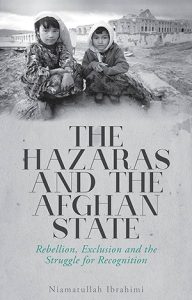The Hazaras and the Afghan State: Rebellion, Exclusion and the Struggle for Recognition

Author: Niamatullah Ibrahimi
Publisher: Hurst Publishers
Year of Publication: 2022 (Paperback Edition)
Print Length: 288 pages
Genre: Non-Fiction / History, Political Science, Social Science, Ethnic Studies
Area: Afghanistan
People: Afghan, The Hazaras, Muslim
Topic: Rebellion, Exclusion, Marginalization, Social Movement, Resistance, Recognition, Sunni & Shia, Ethnic Cleansing, Ethnic & Ethnicity, Dispossession, Othering & Otherness, Minority Rights, Slavery, Nation-Building & Nationhood, National Consciousness, State Formation, Jihad, Battle & Conquest, Factionalism, Civil War, History, Muslim World, Politics & Power, Refugees & Forced Migration, Economy, Culture & Society; Modernity, Modernism, Modern; Historical Reconstruction
The Hazaras of Afghanistan have borne the brunt of many of the destructive forces unleashed by the establishment of the Afghan monarchy in 1747. The history of their relationship with the Afghan state has been punctuated by frequent episodes of ethnic cleansing, mass dispossession, forced displacement, enslavement and social and economic exclusion. Mostly Shia in a country dominated by Sunni Muslims, and identifiable because of their Asian features, the Hazaras became Afghanistan’s internal ‘Other’. They look different and practise a different school of Islam in a country that is prone to internal conflict and the machinations of external powers. The history of the Hazaras therefore offers a unique perspective into the deep contradictions of Afghanistan as a modern state, and how its ethnic and religious dynamics continue to undermine the post-2001 political process.
This volume provides a fresh account of both the strategies and tactics of the Afghan state and how the Hazaras have responded to them, focusing on three key phenomena: Hazara rebellion and resistance to the intrusion of the Afghan state in the nineteenth century; the incorporation of the Hazara homeland into Afghanistan in the 1890s and their subsequent marginalisation and exclusion; and the Hazaras’ ethnic mobilisation and struggle for recognition in recent decades.
‘Ibrahimi’s impressively detailed history helps us to make sense of the current political situation in Afghanistan … throughout the book Ibrahimi adopts a healthy critical stance towards essentialist theories of ethnicity. He aptly shows that to get a full picture of Afghan politics it is necessary to both zoom out to the global and transnational level, and zoom in below the provincial level.’ — The Times Literary Supplement
Table of Contents
Acknowledgements
Glossary
Introduction: The Modern State, Wars, and Ethnic Politics in Afghanistan
The ethnic landscape of Afghanistan / The modern state and ethnic politics in Afghanistan / War-centric and state-centric explanations / The argument and approach of this book / The structure of this book
1. Ethnic and Tribal Politics in Transition from Empire to Statehood
Introduction / Transition from the Durrani empire to the kingdom of Kabul / Internalisation of jehad and conquest / The Hazaras and the Durrani rulers / Conclusion
2. State-Building, Violence and Rebellions: The Period of Amir Abdur Rahman Khan, 1880-1901
Introduction / State-building and rebellions / Abdur Rahman Khan and the Hazaras during the 1880s / The Hazara War / The aftermath of the conquest of Hazarajat / Massacres and destructions in the course of the war / Conclusion
3. The Afghan State and the Hazaras from 1901 to 1978: Afghan Nationalism and Policies and Politics of Modernisation and Exclusion
Introduction / Continuity and ruptures in the historical trajectory of the Afghan State: 1901-1978 / Ethnic and national conceptions of nationhood / The state and ethnic power relations in Hazarajat / Shift from Hazaras’ traditional local rebellion to modern national protest / Conclusion
4. The Rise and Fall of a Clerical Proto-state: Hazarajat 1979-1984
Introduction / The origins of the Shura: A state within a state / The Shura and emerging ideological and political conflicts among the Hazaras / Civil and military structure of the Shura / The Shura‘s diplomacy / Conclusion
5. At the Sources of Factionalism and Civil War in Hazarajat: 1981-1989
Introduction / The first civil war within the clergy: Islamist versus traditionalists / The second civil war: Islamists versus Islamists / The rise of the military class and its destabilizing role / Conclusion
6. The Shift from Internal Wars of Domination to National Struggles for Recognition: Hazaras and Ethnicisation of Politics and War in 1990s
Introduction / The shift from internal Hazara politics to national politics: 1989-1992 / Hezb-eWahdat and the Mujahedin government / Taliban, re-conquest and centralisation / Resistance or collaboration: 1998-2001 / Conclusion
7. International Intervention, Statebuilding and Ethnic Politics, 2001-2016
Introduction / The ideals and practices of ethnic and political pluralism, 2001-2016 / Responding to the opportunities of the post-2002 political order / Rewarding violence in distribution of development assistance / Conclusion
Conclusion
Revisiting the main argument of the book / State-building as historical reconstruction
Notes
Bibliography
Index

Niamatullah Ibrahimi is a Senior Lecturer in International Relations at La Trobe University in Melbourne. He has published extensively on Afghanistan’s politics and history. He is also the co-author (with Professor William Maley) of ‘Afghanistan: Politics and Economics in a Globalising State’. He teaches subjects on Middle East politics, international organisations, and security. His research interests include political violence, peacebuilding, post-conflict political orders, social movements and contentious politics, nationalism and ethnic politics, and human rights and transitional justice. Dr. Ibrahimi completed his PhD in 2018 at the Australian National University where his doctoral research examined the dynamics of contentious politics in the context of the post-2001 international intervention in Afghanistan. From 2018 to 2020, he worked as an Associate Research Fellow at the Alfred Deakin Institute for Citizenship and Globalisation at Deakin University. Previously, he worked for several leading think-tanks and international organisations, including the International Crisis Group and the Crisis States Research Centre of the London School of Economics.
Source: https://www.hurstpublishers.com/book/hazaras-afghan-state/ & https://scholars.latrobe.edu.au/nibrahimi
More from Niamatullah Ibrahimi in this library, click here.
